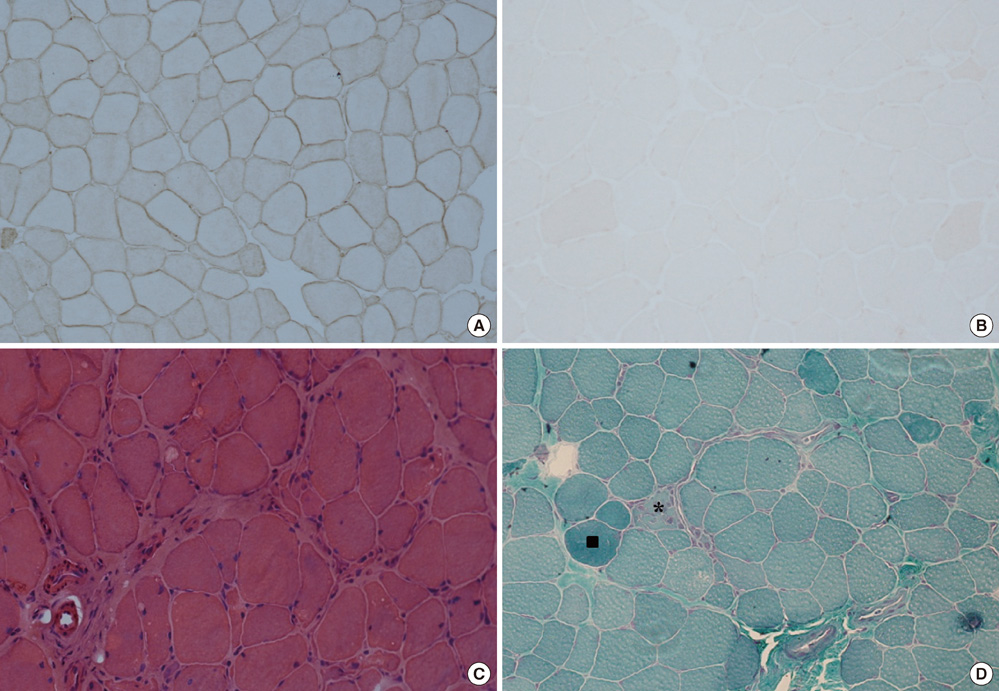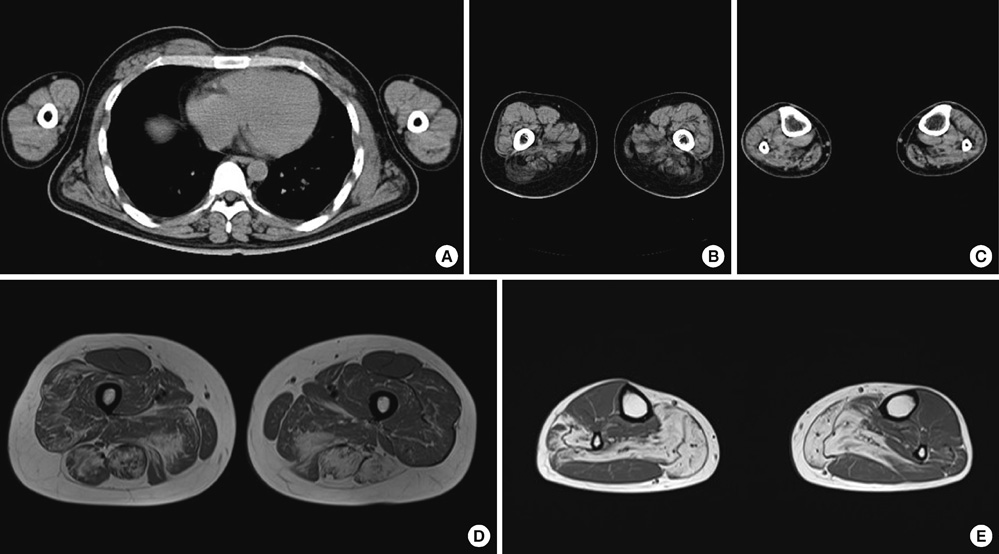J Korean Med Sci.
2012 Apr;27(4):423-429. 10.3346/jkms.2012.27.4.423.
Heterogeneous Characteristics of Korean Patients with Dysferlinopathy
- Affiliations
-
- 1Department of Neurology, Brain Korea 21 Project for Medical Science, Yonsei University College of Medicine, Seoul, Korea. ycchoi@yuhs.ac
- 2Department of Neurology, The Catholic University of Korea College of Medicine, Seoul, Korea.
- 3Department of Neurology, Kangbuk Samsung Hospital, Sungkyunkwan University School of Medicine, Seoul, Korea.
- KMID: 2157904
- DOI: http://doi.org/10.3346/jkms.2012.27.4.423
Abstract
- Dysferlinopathy is caused by mutations in the DYSF gene. To characterize the clinical spectrum, we investigated the characteristics of 31 Korean dysferlinopathy patients confirmed by immunohistochemistry. The mean age of symptom onset was 22.23 +/- 7.34 yr. The serum creatine kinase (CK) was highly increased (4- to 101-fold above normal). The pathological findings of muscle specimens showed nonspecific dystrophic features and frequent inflammatory cell infiltration. Muscle imaging studies showed fatty atrophic changes dominantly in the posterolateral muscles of the lower limb. The patients with dysferlinopathy were classified by initial muscle weakness: fifteen patients with Miyoshi myopathy phenotype (MM), thirteen patients with limb girdle muscular dystrophy 2B phenotype (LGMD2B), two patients with proximodistal phenotype, and one asymptomatic patient. There were no differences between LGMD2B and MM groups in terms of onset age, serum CK levels and pathological findings. Dysferlinopathy patients usually have young adult onset and high serum CK levels. However, heterogeneity of clinical presentations and pathologic findings upon routine staining makes it difficult to diagnose dysferlinopathy. These limitations make immunohistochemistry currently the most important method for the diagnosis of dysferlinopathy.
MeSH Terms
-
Adolescent
Adult
Age of Onset
Creatine Kinase/blood
Distal Myopathies/pathology
Female
Humans
Immunohistochemistry
Male
Membrane Proteins/genetics
Middle Aged
Muscle Proteins/genetics
Muscular Atrophy/pathology
Muscular Dystrophies, Limb-Girdle/*diagnosis/genetics/pathology
Mutation
Phenotype
Republic of Korea
Tomography, X-Ray Computed
Young Adult
Figure
Cited by 1 articles
-
Whole-Body Muscle MRI in Patients with Hyperkalemic Periodic Paralysis Carrying the SCN4A Mutation T704M: Evidence for Chronic Progressive Myopathy with Selective Muscle Involvement
Young Han Lee, Hyung-Soo Lee, Hyo Eun Lee, Seok Hahn, Tai-Seung Nam, Ha Young Shin, Young-Chul Choi, Seung Min Kim
J Clin Neurol. 2015;11(4):331-338. doi: 10.3988/jcn.2015.11.4.331.
Reference
-
1. Liu J, Aoki M, Illa I, Wu C, Fardeau M, Angelini C, Serrano C, Urtizberea JA, Hentati F, Hamida MB, Bohlega S, Culper EJ, Amato AA, Bossie K, Oeltjen J, Bejaoui K, McKenna-Yasek D, Hosler BA, Schurr E, Arahata K, de Jong PJ, Brown RH Jr. Dysferlin, a novel skeletal muscle gene, is mutated in Miyoshi myopathy and limb girdle muscular dystrophy. Nat Genet. 1998. 20:31–36.2. Bansal D, Campbell KP. Dysferlin and the plasma membrane repair in muscular dystrophy. Trends Cell Biol. 2004. 14:206–213.3. Bansal D, Miyake K, Vogel SS, Groh S, Chen CC, Williamson R, McNeil PL, Campbell KP. Defective membrane repair in dysferlin-deficient muscular dystrophy. Nature. 2003. 423:168–172.4. Han R. Muscle membrane repair and inflammatory attack in dysferlinopathy. Skeletal Muscle. 2011. 1:10.5. Klinge L, Laval S, Keers S, Haldane F, Straub V, Barresi R, Bushby K. From T-tubule to sarcolemma: damage-induced dysferlin translocation in early myogenesis. FASEB J. 2007. 21:1768–1776.6. Illa I, Serrano-Munuera C, Gallardo E, Lasa A, Rojas-Garcia R, Palmer J, Gallano P, Baiget M, Matsuda C, Brown RH. Distal anterior compartment myopathy: a dysferlin mutation causing a new muscular dystrophy phenotype. Ann Neurol. 2001. 49:130–134.7. Nguyen K, Bassez G, Krahn M, Bernard R, Laforêt P, Labelle V, Urtizberea JA, Figarella-Branger D, Romero N, Attarian S, Leturcq F, Pouget J, Lévy N, Eymard B. Phenotypic study in 40 patients with dysferlin gene mutations: high frequency of atypical phenotypes. Arch Neurol. 2007. 64:1176–1182.8. Weiler T, Bashir R, Anderson LV, Davison K, Moss JA, Britton S, Nylen E, Keers S, Vafiadaki E, Greenberg CR, Bushby CR, Wrogemann K. Identical mutation in patients with limb girdle muscular dystrophy type 2B or Miyoshi myopathy suggests a role for modifier gene(s). Hum Mol Genet. 1999. 8:871–877.9. Weiler T, Greenberg CR, Nylen E, Halliday W, Morgan K, Eggertson D, Wrogemann K. Limb-girdle muscular dystrophy and Miyoshi myopathy in an aboriginal Canadian kindred map to LGMD2B and segregate with the same haplotype. Am J Hum Genet. 1996. 59:872–878.10. Angelini C. Limb-girdle muscular dystrophies: heterogeneity of clinical phenotypes and pathogenetic mechanisms. Acta Myol. 2004. 23:130–136.11. Moore SA, Shilling CJ, Westra S, Wall C, Wicklund MP, Stolle C, Brown CA, Michele DE, Piccolo F, Winder TL, Stence A, Barresi R, King N, King W, Florence J, Campbell KP, Fenichel GM, Stedman HH, Kissel JT, Griggs RC, Pandya S, Mathews KD, Pestronk A, Serrano C, Darvish D, Mendell JR. Limb-girdle muscular dystrophy in the United States. J Neuropathol Exp Neurol. 2006. 65:995–1003.12. Cho HJ, Sung DH, Kim EJ, Yoon CH, Ki CS, Kim JW. Clinical and genetic analysis of Korean patients with Miyoshi myopathy: identification of three novel mutations in the DYSF gene. J Korean Med Sci. 2006. 21:724–727.13. Oh SH, Kim TS, Choi YC. Identification of a dysferlin gene mutation in a Korean case with Miyoshi myopathy. Yonsei Med J. 2004. 45:927–930.14. Oh SH, Kang SW, Lee JG, Na SJ, Kim TS, Choi YC. Clinical and pathological characteristics of four Korean patients with limb-girdle muscular dystrophy type 2B. J Korean Med Sci. 2004. 19:447–452.15. Choi YC, Park GT, Kim TS, Sunwoo IN, Steinert PM, Kim SY. Sporadic inclusion body myositis correlates with increased expression and cross-linking by transglutaminases 1 and 2. J Biol Chem. 2000. 275:8703–8710.16. Albrecht DE, Garg N, Rufibach LE, Williams BA, Monnier N, Hwang E, Mittal P. 4th Annual Dysferlin Conference 11-14 September 2010, Washington, USA. Neuromuscul Disord. 2011. 21:304–310.17. Rosales XQ, Gastier-Foster JM, Lewis S, Vinod M, Thrush DL, Astbury C, Pyatt R, Reshmi S, Sahenk Z, Mendell JR. Novel diagnostic features of dysferlinopathies. Muscle Nerve. 2010. 42:14–21.18. Klinge L, Aboumousa A, Eagle M, Hudson J, Sarkozy A, Vita G, Charlton R, Roberts M, Straub V, Barresi R, Lochmuller H, Bushby K. New aspects on patients affected by dysferlin deficient muscular dystrophy. J Neurol Neurosurg Psychiatry. 2010. 81:946–953.19. Mahjneh I, Marconi G, Bushby K, Anderson LV, Tolvanen-Mahjneh H, Somer H. Dysferlinopathy (LGMD2B): a 23-year follow-up study of 10 patients homozygous for the same frameshifting dysferlin mutations. Neuromuscul Disord. 2001. 11:20–26.20. Mahjneh I, Passos-Bueno MR, Zatz M, Vainzof M, Marconi G, Nashef L, Bashir R, Bushby K. The phenotype of chromosome 2p-linked limb-girdle muscular dystrophy. Neuromuscul Disord. 1996. 6:483–490.21. Ueyama H, Kumamoto T, Horinouchi H, Fujimoto S, Aono H, Tsuda T. Clinical heterogeneity in dysferlinopathy. Intern Med. 2002. 41:532–536.22. McNally EM, Ly CT, Rosenmann H, Mitrani Rosenbaum S, Jiang W, Anderson LV, Soffer D, Argov Z. Splicing mutation in dysferlin produces limb-girdle muscular dystrophy with inflammation. Am J Med Genet. 2000. 91:305–312.23. Nakagawa M, Matsuzaki T, Suehara M, Kanzato N, Takashima H, Higuchi I, Matsumura T, Goto K, Arahata K, Osame M. Phenotypic variation in a large Japanese family with Miyoshi myopathy with nonsense mutation in exon 19 of dysferlin gene. J Neurol Sci. 2001. 184:15–19.24. Rowin J, Meriggioli MN, Cochran EJ, Sanders DB. Prominent inflammatory changes on muscle biopsy in patients with Miyoshi myopathy. Neuromuscul Disord. 1999. 9:417–420.25. Han R, Frett EM, Levy JR, Rader EP, Lueck JD, Bansal D, Moore SA, Ng R, Beltrán-Valero de Bernabé D, Faulkner JA, Campbell KP. Genetic ablation of complement C3 attenuates muscle pathology in dysferlin-deficient mice. J Clin Invest. 2010. 120:4366–4374.26. Nagaraju K, Rawat R, Veszelovszky E, Thapliyal R, Kesari A, Sparks S, Raben N, Plotz P, Hoffman EP. Dysferlin deficiency enhances monocyte phagocytosis: a model for the inflammatory onset of limb-girdle muscular dystrophy 2B. Am J Pathol. 2008. 172:774–785.27. Rawat R, Cohen TV, Ampong B, Francia D, Henriques-Pons A, Hoffman EP, Nagaraju K. Inflammasome up-regulation and activation in dysferlin-deficient skeletal muscle. Am J Pathol. 2010. 176:2891–2900.28. Choi JH, Park YE, Kim SI, Kim JI, Lee CH, Park KH, Kim DS. Differenrial immunohistological feautres of inflammatory myopathies and dysferlinopathy. J Korean Med Sci. 2009. 24:1015–1023.29. Aoki M, Liu J, Richard I, Bashir R, Britton S, Keers SM, Oeltjen J, Brown HE, Marchand S, Bourg N, Beley C, McKenna-Yasek D, Arahata K, Bohlega S, Cupler E, Illa I, Majneh I, Barohn RJ, Urtizberea JA, Fardeau M, Amato A, Angelini C, Bushby K, Beckmann JS, Brown RH Jr. Genomic organization of the dysferlin gene and novel mutations in Miyoshi myopathy. Neurology. 2001. 57:271–278.30. Takahashi T, Aoki M, Tateyama M, Kondo E, Mizuno T, Onodera Y, Takano R, Kawai H, Kamakura K, Mochizuki H, Shizuka-Ikeda M, Nakagawa M, Yoshida Y, Akanuma J, Hoshino K, Saito H, Nishizawa M, Kato S, Saito K, Miyachi T, Yamashita H, Kawai M, Matsumura T, Kuzuhara S, Ibi T, Sahashi K, Nakai H, Kohnosu T, Nonaka I, Arahata K, Brown RH Jr, Itoyama Y. Dysferlin mutations in Japanese Miyoshi myopathy: relationship to phenotype. Neurology. 2003. 60:1799–1804.
- Full Text Links
- Actions
-
Cited
- CITED
-
- Close
- Share
- Similar articles
-
- Differential Immunohistological Features of Inflammatory Myopathies and Dysferlinopathy
- Myelodysplastic syndromes and overlap syndromes
- Dysferlin Expression in Skeletal muscles of Patients with Myopathy and Cultured Human Myoblast/Myotube
- Application of Generalized Batho Method to Arbitrary Shape of Heterogeneous Tissues
- Analysis of Peritumoral Edema in MRI of Meningioma



